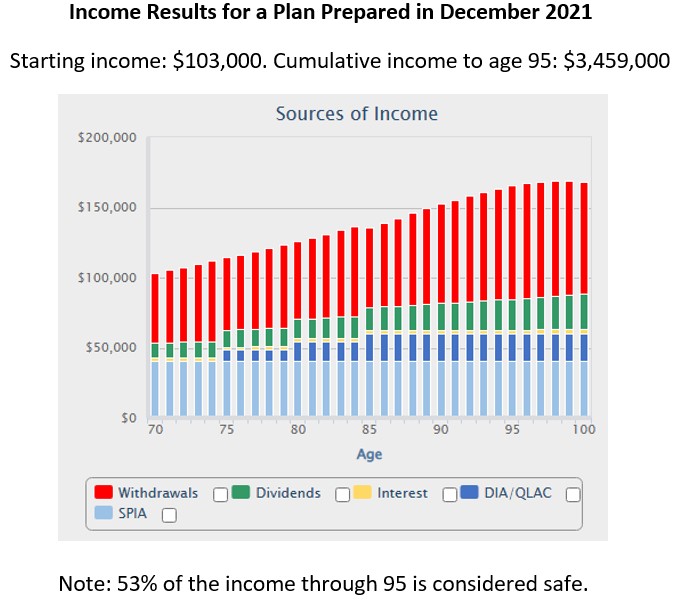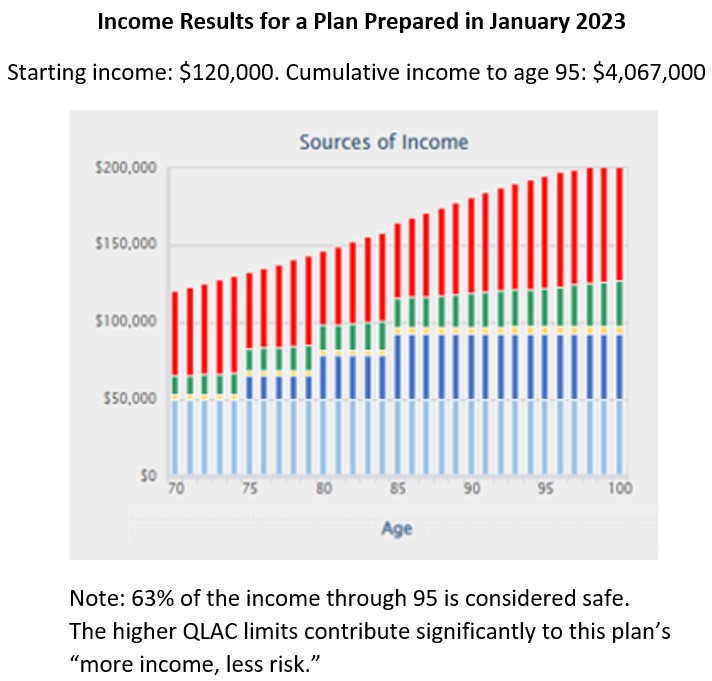Curious About a QLAC? SECURE 2.0 Act Gives This Annuity a Boost
New legislation raises the amount you can transfer from your rollover IRA to a qualifying longevity annuity contract (QLAC), reducing RMDs and increasing guaranteed lifetime income.


The SECURE 2.0 Act of 2022, enacted at the end of December, contains provisions that make it much easier to purchase a pension-like annuity called a QLAC for your retirement income plan. The new legislation allows you to defer more taxes and buy more retirement income from your 401(k), rollover IRA or similar tax-qualified accounts. The maximum QLAC per individual is now $200,000 with no percentage-of-savings limit.
Combine this with the higher annuity payouts due to higher interest rates from these vehicles, and we’re talking about 100% to 250% more income from this source when compared to December 2021. Importantly, QLACs, or qualifying longevity annuity contracts, are offered only by some of the highest-rated insurance companies in the U.S.
What is a QLAC and how does it work?
A QLAC is technically a deferred income annuity purchased by a tax-free transfer of a portion of your tax-qualified accounts generally made after age 55. That transfer, in addition to adding a QLAC to your plan, represents a reduction in your account for the purposes of determining taxable required minimum distributions, or RMDs. So, if you used 25% of a $400,000 qualified account, your $100,000 purchase of a QLAC would reduce your RMDs by 25%. And the income from a QLAC could be deferred until as late as age 85.
From just $107.88 $24.99 for Kiplinger Personal Finance
Become a smarter, better informed investor. Subscribe from just $107.88 $24.99, plus get up to 4 Special Issues

Sign up for Kiplinger’s Free Newsletters
Profit and prosper with the best of expert advice on investing, taxes, retirement, personal finance and more - straight to your e-mail.
Profit and prosper with the best of expert advice - straight to your e-mail.
While tax deferral to age 85 is nice and has a real economic value, it is also important to think about how you can use the income benefits of that $100,000 investment to improve your retirement. Let me give you two examples:
- A couple, both age 65 with a retirement income plan that’s in good shape, wants to ensure they can pay premiums on their long-term care and life insurance late in retirement. They can use the $100,000 to purchase lifetime income starting at age 85 of $36,000 per year — guaranteed. More than enough to pay the premiums.
- If you’re single but your retirement income plan is a little shaky after the financial upsets of 2022, and you’re concerned about inflation, you can use the QLAC to ladder guaranteed income that starts at age 75 and continues to grow. More about that in the example below.
Background on the SECURE 2.0 Act
Most of the news reporting about SECURE 2.0 has focused on the other parts of the legislation that make it easier for part-time employees and employers to create savings plans, along with an extension to age 73 at which age RMDs must be claimed. It also permits unused 529 accounts to be applied to a Roth account. For an overview of what’s in the legislation, see SECURE 2.0 Act Changes 401(k), IRA, Roth, and Other Retirement Plan Rules.
At the same time, many retirement advisers have been caught unaware of the QLAC provisions. (I’m being generous. Your adviser may not talk about a QLAC or income annuities generally because they don’t have the planning software to provide guidance to customers.)
Rules in the 2019 legislation that created the original SECURE Act (stands for Setting Every Community Up for Retirement Enhancement) limited the tax-deferred investments into a QLAC to $125,000, (with adjustments for inflation) or 25% of the account if lower. As mentioned above, the new rules allow up to $200,000 of tax-benefitted savings toward a QLAC, and the percentage-of-savings requirement has been removed.
Another benefit is included in the SECURE 2.0 Act: You can now include a “return of premium” feature in your QLAC so that the purchase amount, less any payouts, goes to a beneficiary at your passing.
What the higher QLAC limits could mean to you
QLAC investors at the legislative maximum get two simultaneous tax benefits: $200,000 is excluded from the RMD test, and the QLAC income can be deferred to later in retirement. Together with income from the balance of qualified savings and Social Security, the retiree can more easily meet income needs for life, while creating liquidity for other needs late in retirement.
To demonstrate, if in December 2021 a male aged 70 used $135,000 (the 2021 maximum) to purchase a QLAC, it would have paid income of $38,000 at age 85. Now, just a little more than a year later, you could purchase income of $75,000 a year. That’s because of the increase in the QLAC maximum to $200,000 a year combined with the higher interest-rate-based payout. (You can get a personalized quote that shows how a QLAC could work for you.)
For that same 70-year-old male, the examples below show similar improvement with a Go2Income Plan for Retirement Income that utilizes dividends, interest payments, IRA withdrawals and annuity payments. (For more information, see For Sustainable Retirement Income, You Need These 5 Building Blocks.)


Another view of the QLAC
Mark Iwry is a former Treasury Department official who helped create QLAC during the Obama administration, and he also consulted on the expansion of QLAC provisions in SECURE 2.0. He told the Retirement Income Journal that QLACs can especially benefit women, who are the most likely to live into their 90s.
“The combination of mortality pooling and predictable investment for 15 to 20 years produces a meaningful add-on to Social Security income starting at 80 or 85,” Iwry told the online journal. “Never mind that Homer (Simpson) thinks all those beers and cheeseburgers mean he’ll never live past 80. The QLAC is for Marge.”
Whether you’re male, female or a couple, a QLAC is a financial instrument that should be considered.
For a specific look at the changes a QLAC could make in your own retirement, visit Go2Income for a complimentary Plan for Retirement Income. This funny-sounding idea that was just expanded through legislation is something you should consider.
related content
- Even After a Year Like 2022, Your Retirement Income Plan Can Stay on Course
- Finding Peace of Mind With Your Retirement Income
- How Much More Retirement Income Can You Get?
- Don’t Bet Your Retirement on Stocks: Follow These Four Tips
- Can AI Plan Your Retirement Better Than I Can?
Profit and prosper with the best of Kiplinger's advice on investing, taxes, retirement, personal finance and much more. Delivered daily. Enter your email in the box and click Sign Me Up.

Jerry Golden is the founder and CEO of Golden Retirement Advisors Inc. He specializes in helping consumers create retirement plans that provide income that cannot be outlived. Find out more at Go2income.com, where consumers can explore all types of income annuity options, anonymously and at no cost.
-
 I'm want to give my 3 grandkids $5K each for Christmas.
I'm want to give my 3 grandkids $5K each for Christmas.You're comfortably retired and want to give your grandkids a big Christmas check, but their parents are worried they might spend it all. We ask the pros for help.
-
 If You're Not Doing Roth Conversions, You Need to Read This
If You're Not Doing Roth Conversions, You Need to Read ThisRoth conversions and other Roth strategies can be complex, but don't dismiss these tax planning tools outright. They could really work for you and your heirs.
-
 Could Traditional Retirement Expectations Be Killing Us?
Could Traditional Retirement Expectations Be Killing Us?A retirement psychologist makes the case: A fulfilling retirement begins with a blueprint for living, rather than simply the accumulation of a large nest egg.
-
 I'm a Financial Planner: If You're Not Doing Roth Conversions, You Need to Read This
I'm a Financial Planner: If You're Not Doing Roth Conversions, You Need to Read ThisRoth conversions and other Roth strategies can be complex, but don't dismiss these tax planning tools outright. They could really work for you and your heirs.
-
 Could Traditional Retirement Expectations Be Killing Us? A Retirement Psychologist Makes the Case
Could Traditional Retirement Expectations Be Killing Us? A Retirement Psychologist Makes the CaseA retirement psychologist makes the case: A fulfilling retirement begins with a blueprint for living, rather than simply the accumulation of a large nest egg.
-
 I'm a Financial Adviser: This Is How You Can Adapt to Social Security Uncertainty
I'm a Financial Adviser: This Is How You Can Adapt to Social Security UncertaintyRather than letting the unknowns make you anxious, focus on building a flexible income strategy that can adapt to possible future Social Security changes.
-
 I'm a Financial Planner for Millionaires: Here's How to Give Your Kids Cash Gifts Without Triggering IRS Paperwork
I'm a Financial Planner for Millionaires: Here's How to Give Your Kids Cash Gifts Without Triggering IRS PaperworkMost people can gift large sums without paying tax or filing a return, especially by structuring gifts across two tax years or splitting gifts with a spouse.
-
 'Boomer Candy' Investments Might Seem Sweet, But They Can Have a Sour Aftertaste
'Boomer Candy' Investments Might Seem Sweet, But They Can Have a Sour AftertasteProducts such as index annuities, structured notes and buffered ETFs might seem appealing, but sometimes they can rob you of flexibility and trap your capital.
-
 Quick Question: Are You Planning for a 20-Year Retirement or a 30-Year Retirement?
Quick Question: Are You Planning for a 20-Year Retirement or a 30-Year Retirement?You probably should be planning for a much longer retirement than you are. To avoid running out of retirement savings, you really need to make a plan.
-
 Don't Get Caught by the Medicare Tax Torpedo: A Retirement Expert's Tips to Steer Clear
Don't Get Caught by the Medicare Tax Torpedo: A Retirement Expert's Tips to Steer ClearBetter beware, because if you go even $1 over an important income threshold, your Medicare premiums could rise exponentially due to IRMAA surcharges.
-
 I'm an Insurance Pro: Going Without Life Insurance Is Like Driving Without a Seat Belt Because You Don't Plan to Crash
I'm an Insurance Pro: Going Without Life Insurance Is Like Driving Without a Seat Belt Because You Don't Plan to CrashLife insurance is that boring-but-crucial thing you really need to get now so that your family doesn't have to launch a GoFundMe when you're gone.